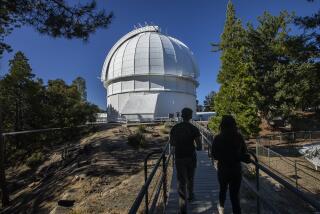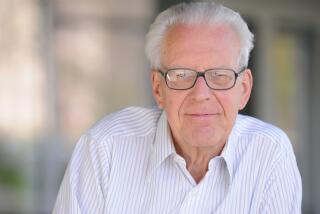A Cosmic Experience for Camarillo Teacher
- Share via
Until June, Jatila van der Veen was known in Camarillo for teaching physics and astronomy.
Now she’s known at Cape Canaveral for naming the world’s most sophisticated satellite.
From the time it was proposed in 1976, it was known, inelegantly, as AXAF, for Advanced X-Ray Astrophysics Facility.
Now it’s called Chandra.
In Florida over the past few days, they’ve been raising toasts to Chandra, and to Van der Veen. After it’s catapulted into space, as early as Thursday, Chandra will give scientists their closest look ever at such cosmic mysteries as black holes.
“It’s been incredibly exciting,” Van der Veen said from her Cocoa Beach hotel. There have been luncheons and briefings and news conferences, for both Van der Veen and the Idaho 10th-grader who also is credited with naming the 45-foot-long satellite.
On a VIP tour, Van der Veen came as close to the launching pad as any human who isn’t destined for orbit. At a reception, she saw Judy Collins sing a song she wrote for the launch--”It’ll be a hit single, definitely,” Van der Veen predicted.
Van der Veen was there at Monday night’s countdown--as were Hillary Clinton and the U.S. Women’s World Cup team--when the flight was scrubbed six seconds from liftoff.
“It was frightening,” she said. “After this big production, this big send-off, we were listening to the countdown, and they suddenly stopped. There was silence.”
Excess hydrogen had been detected aboard the shuttle. For Van der Veen, the announcement was sobering: “In another second, the engines would have ignited. If there had been a leak, there would have been an incredible explosion, killing the astronauts and destroying Chandra, and 25 years of work. Thank God they caught it.”
There was no leak, as it turned out. Barring any further problems, liftoff will occur Thursday at 12:28 a.m. Once it has soared 155 miles above the Earth, the space shuttle Columbia will hurl Chandra into orbit.
Reading the X-rays emitted by celestial objects, Chandra will probe the heavens with 100 times more accuracy than any space telescope before it. The mirrors it will use to focus light are smoother than any ever created.
In a million light-years, the name Chandra wouldn’t have occurred to me.
I would have suggested something less inspired for the $2.5-billion telescope. Maybe I would have come up with something like “Eyeful Tower.” Or “Sir Lens-a-Lot.” My entry would have betrayed my lack of taste and my ignorance of astronomy, both of which are as vast as space itself.
But those were obstacles Van der Veen didn’t have to overcome.
A teacher for 10 years at Camarillo High School, she has always loved space. She said she took her graduate degree in seismology because she didn’t think she was smart enough to master astrophysics. This fall, she will start a full-time faculty position at UC Santa Barbara--a school her son entered at 14 and just left, at 17, for a lucrative job designing computer games.
Last year, Van der Veen beat out 60,000 other entrants in NASA’s name-the-satellite contest. Because the shuttle will be piloted by Eileen Collins, women’s names were popular. Many entrants suggested Curie, to honor the woman who discovered the X-ray. One entrant pitched Cecilia, for a pioneering astronomer praised by a colleague both as “the most eminent woman astronomer of all time” and as “the best man at Harvard.”
So why did 59 entrants go for Chandra?
It’s the nickname of Subrahmanyan Chandrasekhar, a Nobel laureate in physics who died in 1995.
Plus, it’s Sanskrit for “moon,” pointed out Van der Veen, who studied dance for a year in India.
Astrophysicists revere Chandra.
Van der Veen called him “a courageous pioneer.”
In her winning essay she noted that he is “famous for the Chandrasekhar Limit,” the discovery of 1.4 solar masses as the greatest mass a star can have without perishing violently in an explosion.
A couple of days ago, Van der Veen dined with his widow, who presented Van der Veen with a 1928 paper he wrote on “The Non-Radial Oscillation of Stars.”
I didn’t ask what that was. I merely asked if it was a seminal work, hoping I knew what that meant.
Van der Veen laughed.
“All of Chandra’s works were seminal,” she said.
Steve Chawkins is a Times staff writer. His e-mail address is steve.chawkins@latimes.com.







